Spirit Chases a Martian Mirage
by Wal Thornhill | January 23, 2004 8:53 am
While this report was being written came worrying news that the Mars Exploration Rover, Spirit, is not functioning normally.
On January 21, 2004 ground controllers were able to send commands to Spirit and received a simple signal acknowledging that the rover heard them, but they did not receive expected scientific and engineering data during scheduled communication passes during the rest of that martian day.
Project managers have not yet determined the cause, but similar events occurred several times during the Mars Pathfinder mission. The team is examining a number of different scenarios, some of which would be resolved when the rover wakes up after powering down at the end of the martian day (around midday Pacific time Wednesday).
As discussed later in this report, Spirit is moving about in an area where there are frequent dust devils. The dust devils are not simply rotating winds caused by rising warm air. They are the form lightning takes in the thin Martian atmosphere. So they are a great hazard to surface craft, with their powerful electrostatic and electromagnetic effects. Just as the Galileo spacecraft suffered repeated computer glitches when it flew too close above the plumes of the electrical jets on Io, it is possible that Spirit has become a lightning rod and suffered internal arcing – with possibly serious consequences for its onboard electronics. I sincerely hope not!
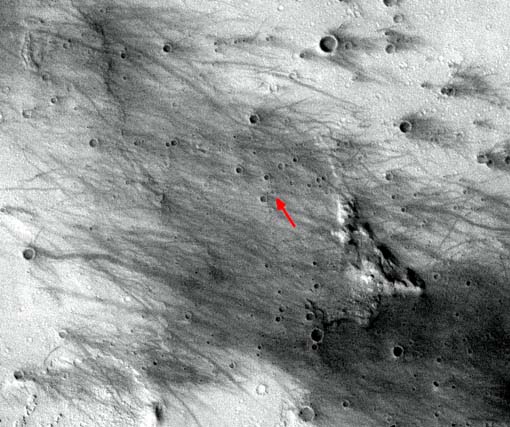
The official caption shows the problem of perception facing scientists who are trained to believe that planets are electrically inert bodies and that weather is caused largely by solar heating. The MER engineers have done a great job within the limitations of what scientists have told them to expect. And therein lies the greatest weakness in our exploration of space.
Postscript January 29, 2004
“We’re back on track now, after getting a pretty serious scare from Spirit. Spirit’s problems seem to have been caused by little more than a fouled-up computer file system… not too different from what can happen when you hit the power button on your computer accidentally and corrupt a bunch of files on your hard drive. The JPL flight software team is hot on the trail of this thing now, and I’m hoping that Spirit will make a full recovery.”
– From Mars Mission News by Steve Squyres at Cornell University.
Since no Martians have been spotted gazing into Spirit’s cameras, we must assume there was no extraterrestrial digit to ‘hit the power button.’ But you can get the same effect on your home computer when lightning strikes in the neighborhood.
Mars is not a hospitable planet. In August last year I wrote: “Gigantic fresh scars show that Mars has suffered recently and terribly. Millions of cubic kilometres of jagged boulders were burnt and torn from its surface and strewn from horizon to horizon – as all of the images relayed from the surface have shown. The implications for the search for life on Mars are profound.
If there was a past environment conducive to life on Mars it has been wrecked. Not only the surface suffered but also the atmosphere was stripped and exogenous gases and solids dumped on the hapless planet. Mars’ orbit and climate changed drastically.”
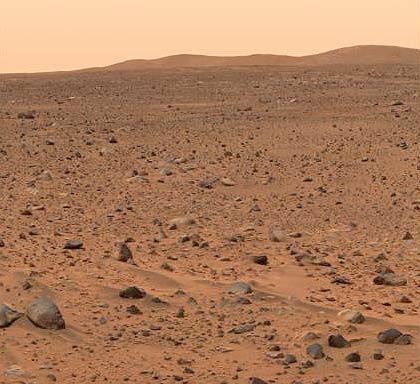
The Mars Exploration Rover, Spirit, is adding to the weight of evidence for this catastrophic scenario. Once again we saw a rock-strewn vista when Spirit first “opened its eyes.” Over the coming months, while Mars comes under intense investigation, both from orbit and rovers on the surface, it is a great opportunity to predict what will be found and to compare the conventional view of Mars with that of the ELECTRIC UNIVERSE®.
Spirit is examining the floor of Gusev Crater, which terminates a large channel called Ma’adim Vallis. I wrote about Ma’adim Vallis in July 2002, in “Water on Mars?[1]”: “.. what is the story of the formation of Ma’adim Vallis? An arc cutting Gusev crater will sap electrons from the surrounding terrain by creating a strong radial electric field that begins to rip electrons from the solid surface. When breakdown begins, a lightning bolt tears across the surface, blasting soil and rock to either side of its sinuous path. A large proportion of the excavated material is impelled electrostatically to follow the main discharge toward space. Pieces not pulled into space would fall back in a more or less random scattering all over Mars. That explains why there is little evidence of deposition inside Gusev Crater from a channel that is larger than the Grand Canyon. It is also the reason why every Mars lander has returned a vista of rubble that extends to the horizon.”
See Carving Ma’adim Vallis[2] for a conventional explanation.
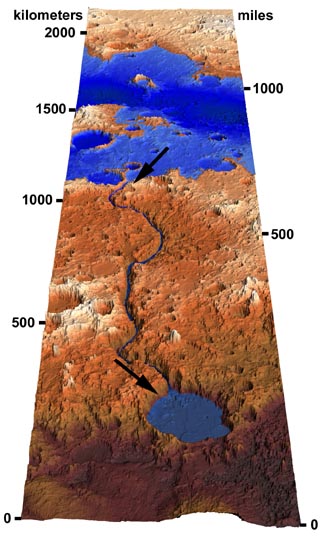
Already scientists have begun to express surprise at the information streaming back from Spirit.
From the press release of 19 January:
Scientists chose Adirondack to be Spirit’s first target rock rather than another rock, called Sashimi, that would have been a shorter, straight-ahead drive. Rocks are time capsules containing evidence of the environmental conditions of the past, said Dr. Dave Des Marais, a rover science-team member from NASA Ames Research Center, Moffett Field, Calif. “We needed to decide which of these time capsules to open.”
Sashimi appears dustier than Adirondack. The dust layer could obscure good observations of the rock’s surface, which may give information about chemical changes and other weathering from environmental conditions affecting the rock since its surface was fresh. Also, Sashimi is more pitted than Adirondack. That makes it a poorer candidate for the rover’s rock abrasion tool, which scrapes away a rock’s surface for a view of the interior evidence about environmental conditions when the rock first formed. Adirondack has a “nice, flat surface” well suited to trying out the rover’s tools on their first martian rock, Des Marais said.
“The hypothesis is that this is a volcanic rock, but we’ll test that hypothesis,” he said.
Comment: Most of the soil and rock found on Mars has been recently excavated from the depths of craters, canyons and channels, like Ma’adim Vallis, elsewhere on Mars. To gain some perspective, the Valles Marineris canyons are up to 9 kilometers deep. Mars is a major source of meteorites and asteroidal bodies (just two of the latter remain as Mars’ tiny moons, Phobos and Deimos). If the rocks are “time capsules” from the past it is a very recent past. They have had no time to weather. And the story they have to tell will not fit any conventional geological theory.
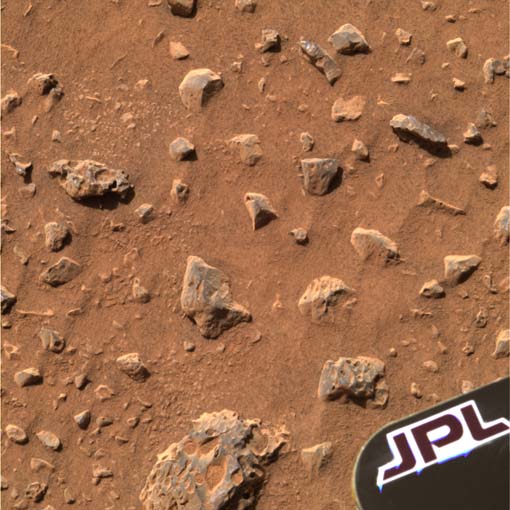
The scattered rocks are not likely to be volcanic. Many will have suffered plasma heating and shock effects from a cosmic electric discharge. The holes in some of the rock surfaces may be plasma arc craters or they may be due to trapped gases being explosively released by hot plasma.
Unweathered surface mineral
From the press release of 20 January:
“”We’re starting to put together a picture of what the soil at this particular place in Gusev Crater is like. There are some puzzles and there are surprises,” said Dr. Steve Squyres of Cornell University, Ithaca, N.Y., principal investigator for the suite of instruments on Spirit and on Spirit’s twin, Opportunity.
One unexpected finding was the Moessbauer spectrometer’s detection of a mineral called olivine, which does not survive weathering well. This spectrometer identifies different types of iron-containing minerals; scientists believe many of the minerals on Mars contain iron. “This soil contains a mixture of minerals, and each mineral has its own distinctive Moessbauer pattern, like a fingerprint,” said Dr. Goestar Klingelhoefer of Johannes Gutenberg University, Mainz, Germany, lead scientist for this instrument.
The lack of weathering suggested by the presence of olivine might be evidence that the soil particles are finely ground volcanic material, Squyres said. Another possible explanation is that the soil layer where the measurements were taken is extremely thin, and the olivine is actually in a rock under the soil.
Comment: Olivine is a common mineral found on Earth in recent lavas and meteorites. However, it rapidly breaks down when exposed to water and weathering. The soil and rocks on Mars have lain exposed for a mere few thousand years, not millions or billions of years. They have not been exposed to water or had time to weather.
Cohesive Soil
The news item continues:
”Scientists were also surprised by how little the soil was disturbed when Spirit’s robotic arm pressed the Moessbauer spectrometer’s contact plate directly onto the patch being examined. Microscopic images from before and after that pressing showed almost no change. “I thought it would scrunch down the soil particles,” Squyres said. “Nothing collapsed. What is holding these grains together?”
Comment: Gusev crater is situated in the heavily cratered southern highlands of Mars. Crater floors are formed not by impact but by a rotating arc that neatly machines the circular crater, leaving a flat floor. Many smaller craters were subsequently burnt into the floor of Gusev crater. Today, the area where Spirit landed is covered with the trails of so-called “dust devils.” Normal earthly lightning cannot occur in the thin atmosphere of Mars, Instead it takes the slower diffuse form of a tornado. We should expect the electrical activity on the Martian surface, both in the past and in the present, to produce glassified soil with the cohesive strength of a fulgurite (sand loosely fused by lightning). Electric discharges are sometimes used to immaculately clean a surface. The dark paths left by the Martian dust devils should show microscopic signs of having been cleaned by a corona discharge. I would urge the Spirit team, if possible, to include one of the dark trails in their traverse.
Chlorine and Sulfur
The news item continues:
”Information from another instrument on the arm, an alpha particle X-ray spectrometer, may point to an answer. This instrument “measures X-ray radiation emitted by Mars samples, and from this data we can derive the elemental composition of martian soils and rocks,” said Dr. Johannes Brueckner, rover science team member from the Max Planck Institute for Chemistry, Mainz, Germany. The instrument found the most prevalent elements in the soil patch were silicon and iron. It also found significant levels of chlorine and sulfur, characteristic of soils at previous martian landing sites but unlike soil composition on Earth.
Squyres said, “There may be sulfates and chlorides binding the little particles together.” Those types of salts could be left behind by evaporating water, or could come from volcanic eruptions, he said. The soil may not have even originated anywhere near Spirit’s landing site, because Mars has dust storms that redistribute fine particles around the planet. The next target for use of the rover’s full set of instruments is a rock, which is more likely to have originated nearby.”
Comment: The presence of chlorine and sulfur in the Martian soil is of special interest because sulfur is commonly formed in cosmic discharges by fusing two oxygen atoms together. It is happening today on Io in cathodic arc jets (mistaken for volcanoes) so that its surface is buried in sulfur. (Io was probably an icy satellite originally, like the other Galilean satellites of Jupiter). But there was another more direct source of these elements for the Martian soil – the clouds of Venus!
Venus was identified by the ancients as having discharged spectacularly to Mars for an extended period. For this reason the thin Martian atmosphere still has a whiff of the Venusian atmosphere, with its carbon dioxide and nitrogen. The Russian lander, Venera 12, found that the clouds of Venus hold 20 times as much chlorine as sulfur. This discovery was “so difficult to reconcile with other measurements that American researchers have tended to ignore or discount them, although no one has explained why they should be in error.” [Venus Revealed, D Grinspoon, p. 120.] The Martian soil seems to retain a record of the encounter with Venus. It may also extend to the hematite deposits at the site of Spirit’s twin, Opportunity.
In addition there is a long-standing puzzle concerning the origin of the chlorine in our salty oceans. There is far too little chlorine in rocks to account for it. However, chlorine and sodium are strongly related in low-energy nuclear transformations of light elements, so both Mars and the Earth must have had chlorine added to their surface inventory from external energetic plasma discharge events.
Concentrated plasma discharges are known to produce large numbers of neutrons. We should therefore expect anomalous levels of heavy isotopes formed by neutron capture. So we find the deuterium to hydrogen ratio (D/H) on Venus is “phenomenally high” at 120 times greater than on Earth. On Mars it is enriched 6 times the terrestrial value. It may represent the varying exposures of the three planets to recent cosmic discharge activity. And as was found on the Moon, anomalous radioactivity on Mars may be found to be associated with the focal points of those discharges – recent craters and other electrical scars.
Spirit Finds Carbonates
On Earth, carbonates such as limestone often form in liquid water. But one of the biggest Mars mysteries deals with “missing carbonates.” Orbital images show valleys that look like dry riverbeds, suggesting that liquid water existed on an early Mars that had a thicker atmosphere and a warmer climate. If true, large quantities of carbon dioxide should have dissolved out of Mars’s atmosphere into the water and chemically reacted with other materials to form carbonates. But orbital data from Mars Global Surveyor’s instrument reveal much lower carbonate abundances than predicted.
[From SkyandTelescope.com]
Comment: Spirit has found the telltale signature of carbonates. The problem is to know what tale it is telling. Mars has changed so drastically in the recent past that its story may be indecipherable. But it is certain that it cannot be used to prove that a hypothetical greenhouse existed on Mars aeons ago. Any exogenous interference with Mars’ atmosphere and surface material would tear up this particular history book.
Hollow Mystery for Mars Rover
A close-up image of an undisturbed patch of Martian soil has revealed a large number of hollow spheres or tubes. The Mars rover Spirit has completed its first full set of scientific measurements with the instruments on its robotic arm, revealing mysterious hollow grains in the soil. The one-metre arm used its microscope to take a close-up image of an undisturbed patch of soil next to the NASA rover. It shows mostly sand-sized particles, but with a large number of apparently hollow spheres or tubes.
Such grains were completely unexpected. But John Grotzinger, a geologist at the Massachusetts Institute of Technology, says they closely resemble formations he has seen in soils in the southwestern deserts of the US. “There are little tubes that build up by capillary action,” he told New Scientist, as salty water evaporates from the nearly-dry soil. The Martian grains must also be strong enough to withstand the region’s strong winds and perpetual scouring by dust devils – tornado shaped vortexes that can tower to heights of kilometres.
[From NewScientist.com]
Comment: The lunar surface has been subjected to electrical cratering and channel formation like that on Mars. (The only difference is that scientists have given up the idea that channels, or rilles, on the Moon were formed by water). A report by scientists studying a lunar dust sample remarked upon the large number of small glassy spherules and cylinders. It was their opinion that “they must have been formed free from restraints, perhaps blown from a melt as fine droplets or perhaps as a spray of molten glass; thus they were able to solidify in free flight under influence of surface tension forces. ..it is safe to conjecture that the cylindrical object in its initial molten state was part of a breakup of a thin jet.. A number of the grayish metallic-like spherules exhibit vacuole regions within their otherwise solid interiors..” [Science, Vol. 167, No. 3918, pp. 742-3.]
A cathode arc melts a surface and forms a jet of the melted material. The first microscopic investigation of the Martian soil supports the ELECTRIC UNIVERSE® model. As for the southwestern deserts of the US, they were formed by the same electrical erosion processes that shaped the surface of Mars. We should expect to find many parallels.
The European Space Agency and Mars Express
“In the testing of hypotheses lies the prime difference between the investigator and the theorist. The one seeks diligently for the facts which may overthrow his tentative theory. The other closes his eyes to these, and searches only for those which will sustain it.”
– Grove Karl Gilbert, Chief Geologist of the US Geological Survey, 1895.
In the search for water on Mars there is a powerful human tendency to see only what you expect to find. Contrary data is forgotten or dismissed from consideration. Mirages are easily mistaken for water. For example, while MER is trundling about the surface the European Space Agency (ESA) has Mars Express in orbit about the red planet. ESA has chosen to use one of the most spectacular sights in the solar system – the colossal canyons of Valles Marineris – to publicize their success. Image data from Mars Express has been used to generate a perspective view that is like looking out of an aircraft window.
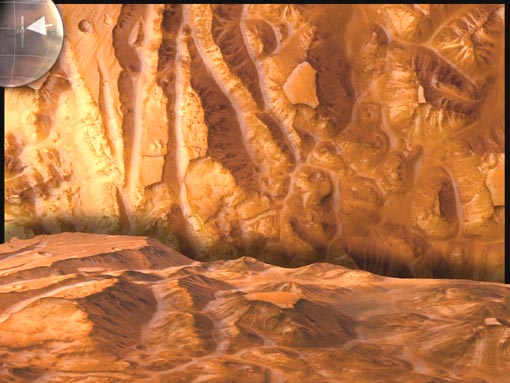
ESA’s news report says, “One looks at a landscape which has been predominantly shaped by the erosional action of water. Millions of cubic kilometres of rock have been removed, and the surface features seen now such as mountain ranges, valleys, and mesas, have been formed.”
This offhanded statement from ESA is not supported by any of the geologists who have studied Valles Marineris. All now attribute the formation of its canyons to faulting of the Martian crust. The experts go on to admit, “However, why the Valles Marineris were faulted to form deep troughs is not known.” It is a mystery because the answer lies outside the expertise of geologists. It was explained in Mars and the Grand Canyon[3] and Spiral Galaxies & Grand Canyons[4].
News releases like the one above are untruthful and self-serving. It seems that both NASA and ESA are dominated by theorists with one eye on funding, not impartial investigators. The great canyons and channels on Mars were not carved by water. There is no need for large volumes of water hidden beneath the surface to explain their peculiar features. The few gullies found in crater walls look as if they have been etched into the wall, not eroded by water. Mars had surface moisture or ice in the recent past as shown by “sloppy” electrical craters but seems to have lost most of it in the energetic events that caused the cratering.
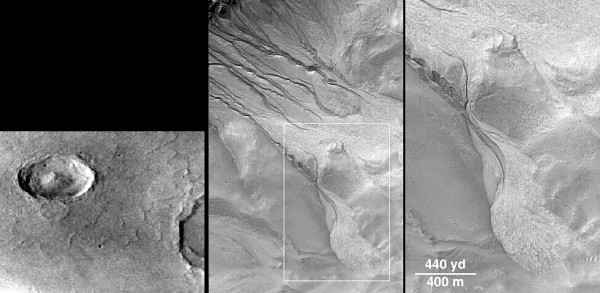 [5]
[5]On the left the caption reads: “Crater formed in soft, probably water-logged ground. Note the splatter marks (lobate flows) around it.”
Impact splatters do not form lobate flows. However, the heat from an electric discharge does cause moisture to ‘sweat’ to the surface and flow slowly away from the crater.
On the right the caption reads: “Channels in a Martian crater probably formed by relatively recent running water.”
In this example the channels were not formed by running water. The close-up on the right shows clearly that the large channel is V-shaped in cross-section with a narrow channel at its base and has transverse striations. The narrow inner channel remains remarkably constant in width. And one channel has crossed another with no sign of any diversion of material into the earlier channel. These features are hallmarks of powerful near-surface electric discharges travelling up the wall of the crater. The fans at the bottom of the channels must then have an electrical origin too, taking the form of diffuse corona discharge streamers.
Sadly, much of the educational information on the ESA website is theory not necessarily supported by observations. We need more people like geologist G. K. Gilbert, who understand the difference between investigator and theorizer. “The one seeks diligently for the facts which may overthrow his tentative theory. The other closes his eyes to these, and searches only for those which will sustain it.”
Potentially billions of dollars are about to be wasted chasing the mirage of hidden water on Mars. But the search for water is only the first step in a quest of mythical proportions – to land humans on Mars. If only scientists understood the origin of the myths about Mars, the planetary god of war, they might begin to see parallels with earlier irrational human feats to reach the home of the gods – as witness the great pyramids. They might also perceive that the shrapnel covered and blasted hero “died” in a battle involving cosmic thunderbolts.
Comparative mythology gives us precise clues about what we should be looking for on Mars and what to expect. It has been far more predictive and explanatory than speculative theories about an undisturbed planet and long-extinct oceans. It gives us a ‘big picture’ of the catastrophic forces that recently shaped the planet’s surface. Meanwhile, bewildered geologists are crying out for a big picture to make sense of the images from Mars orbiters. More urgently, comparative mythology is the key to our dimly remembered astronomical past and offers clues about unanticipated physical and electrical hazards facing Mars explorers. Only with the broad interdisciplinary perspective of the ELECTRIC UNIVERSE® will wisdom have a chance to prevail in our exploration of space.
Wal Thornhill
- Water on Mars?: http://www.holoscience.com/news/wateronmars.html
- Carving Ma’adim Vallis: http://antwrp.gsfc.nasa.gov/apod/ap020627.html
- Mars and the Grand Canyon: http://www.holoscience.com/views/view_mars.htm
- Spiral Galaxies & Grand Canyons: http://www.holoscience.com/news.php?article=rnde0zza
- [Image]: /wp/wp-content/uploads/2012/03/ESA_water.jpg
Source URL: https://www.holoscience.com/wp/spirit-chases-a-martian-mirage/